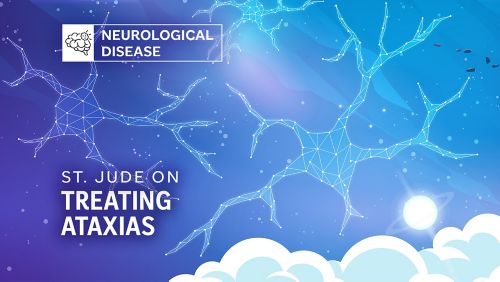St. Jude Family of Websites
Explore our cutting edge research, world-class patient care, career opportunities and more.
St. Jude Children's Research Hospital Home

- Fundraising
St. Jude Family of Websites
Explore our cutting edge research, world-class patient care, career opportunities and more.
St. Jude Children's Research Hospital Home

- Fundraising
Putting together the puzzle of effective Ataxia treatment

Main image caption: Through the St. Jude Pediatric Translational Neuroscience Initiative investigators are working to better treat Ataxias, a group of rare neurologic disorders that affect movement and coordination.
Advances in genetic research over the past 15 years have enabled scientists to identify the cause of a host of debilitating rare diseases. This knowledge has helped accelerate the development of new therapies; however, thousands of rare diseases still have no treatment approved by the Food and Drug Administration. Because about half of rare disease diagnoses occur in children—many of them fatal—the quest to develop new therapies is both urgent and challenging.

Richard Finkel, MD, Director of the St. Jude Center for Experimental Neurotherapeutics (CENT), the clinical component of the Pediatric Translational Neuroscience Initiative (PTNI), has spent the past 30 years helping children diagnosed with neurologic disabilities, many of them rare or ultrarare neurological diseases. It’s an area with high unmet need: current treatments for most rare neurological diseases are either ineffective, inadequate or unavailable.
CENT, which Finkel helped create, was established to change this trajectory. Specifically, CENT’s mission is to take the basic research conducted under the Center for Pediatric Neurological Disease Research (CPNDR), another arm of PTNI, and advance treatments for tractable, genetically defined catastrophic diseases. Movement disorders are one of five areas of interest for CENT, with research directed towards hereditary spastic paraplegia (HSP) and two types of ataxias: Friedreich’s Ataxia (FA) and Ataxia-Telangiectasia (A-T).
“Once you’ve seen a patient with one of these ataxias, it makes a permanent impression and becomes a motivation to try to help these children,” Finkel said. “The children typically lose walking ability within 10 years of diagnosis and have reduced survival as well.”
What are ataxias?
Ataxia refers to both a neurological sign (a symptom of an underlying condition) and a group of rare neurodegenerative disorders that affect movement and coordination. Ataxias collectively affect about 26 out of every 100,000 children. They are typically either inherited, caused by genetic mutations, or acquired due to autoimmune disease, toxicity, infections or vitamin deficiencies.
FA and A-T are caused by changes to the FXN and ATM genes, respectively. Children with FA, the most commonly inherited ataxia, slowly lose muscle coordination, balance, and reflexes. FA may also cause slurred speech, muscle weakness, and vision and hearing problems.
Patients with A-T experience movement and coordination issues and often immune and endocrine system problems. Patients with A-T also develop small clusters of enlarged blood vessels called telangiectasias in the eyes and on their skin’s surface.
People with A-T have about a 40% risk of developing cancer, particularly leukemia and lymphoma. For this reason, these patients may participate in the Cancer Predisposition Program. There, they receive cancer monitoring, genetic counseling and a care plan (if needed).

Richard Finkel, MD, (forward) works with colleagues in the Pediatric Translational Neuroscience Initiative to translate new advances from the laboratory into the clinic.
Uniting to advance Friedreich’s Ataxia treatments
St. Jude collaborates with internal and external partners to advance understanding and potential treatments for FA and A-T. As part of The Friedreich’s Ataxia Global Clinical Consortium (FA-GCC), a research initiative of the Friedreich’s Ataxia Research Alliance (FARA), St. Jude is one of 34 sites taking part in UNIFAI, a natural history study designed to collect data on how FA progresses over time and affects patients’ daily lives.
UNIFAI combines data from two established FA natural history studies: FACOMS (U.S., Canada, Australia, New Zealand, and India) and EFACTS (European countries). The information collected in these studies gives UNIFAI statistical power. With all data harmonized, clinical trial sponsors will have access to a robust database to evaluate new drugs and biologics.
“Uniting these studies gives us information on patients with different racial and ethnic backgrounds,” Finkel added. “In some genetic diseases, there can be contributory factors that cause the disease to progress more rapidly or slowly depending on genetic background.”
UNIFAI participants will visit a study site every year for 25 years. They’ll receive neurological exams, timed walking tests and upper limb function measures, as well as complete clinical outcome and patient-reported quality of life assessments. Sites may collect additional ancillary measures related to speech, vision, fatigue, balance and cognition.
In addition to these measurements, St. Jude works with other FA-GCC sites to develop outcome assessments for younger, recently diagnosed patients. To accomplish this, UNIFAI participants may visit the Gait & Mobility Lab and/or Human Performance Lab for additional, optional tests.
Consortium sites will also participate in a forthcoming trial to study the safety and efficacy of omaveloxolone in children under the age of 16. Currently, omaveloxolone is available in oral form for people aged 16 and up. While not curative, studies have shown improvements in limb coordination, upright stability, swallowing and speech.
Ataxia-telangiectasia
The rarity, complexity and heterogeneity of A-T have made drug development difficult. However, researchers have made progress in understanding its genetic basis and improving diagnostic testing to pinpoint A-T. At St. Jude, Peter McKinnon, PhD, has been studying the cause of A-T and its association with cancer for over 20 years. His research explores the molecular basis for A-T and the reasons for cancer susceptibility, among other topics.
GEMINI, the Genomic Medicine Initiative and Blue-Sky project led by PTNI aims to move that research forward. GEMINI aims to develop precision medicine treatments for children with ultrarare diseases, such as A-T.
“We have a thorough understanding of the gene responsible for A-T and know that it’s potentially targetable with novel therapeutics and individualized treatment strategies,” said Finkel. “There’s also a high unmet need, which makes it a good fit for our program.”
The pursuit of a solution will bring together every component of PTNI. The Center for Pediatric Neurologic Disease Research, directed by McKinnon leads basic research, CENT brings that research into the clinic and the Office of Strategy & Alliances coordinates projects both internally and with external partners.






